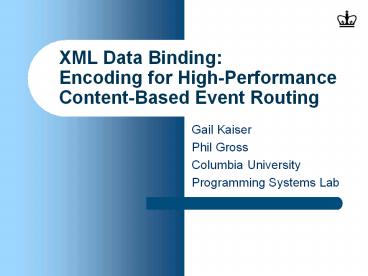XML Data Binding: Encoding for High-Performance Content-Based Event Routing - PowerPoint PPT Presentation
Title:
XML Data Binding: Encoding for High-Performance Content-Based Event Routing
Description:
'PSL conducts research on Web technologies, collaborative work, virtual ... DISCUS: Decentralized Information Spaces for Composition and Unification of Services ... – PowerPoint PPT presentation
Number of Views:40
Avg rating:3.0/5.0
Title: XML Data Binding: Encoding for High-Performance Content-Based Event Routing
1
XML Data BindingEncoding for High-Performance
Content-Based Event Routing
- Gail Kaiser
- Phil Gross
- Columbia University
- Programming Systems Lab
2
Overview
- PSL Intro
- MEET Project
- Encoding Conversion Efficiency
- Encoding Size Efficiency
- Encoding Classification Efficiency
3
Programming Systems Lab
- PSL conducts research on Web technologies,
collaborative work, virtual worlds,
process/workflow, extended transaction models,
software development environments and tools,
software engineering, information management, and
distributed programming systems - Lately, lots of XML stuff
4
PSL XML-related Research
- FlexML Flexible XML
- Open-ended XML streams that may include new
tags - Dynamic schema and semantics discovery and
composition - XUES XML-based Universal Event Service
- Event Packager Data mining over XML structured
data - Event Distiller XML event poset pattern matching
- Learning new application-domain events to
recognize - DISCUS Decentralized Information Spaces for
Composition and Unification of Services - Rapid and secure application composition using
Web Services - Trust Evolution PGP Trust KeyNote real-world
business
5
MEET
- Multiply Extensible Event Transport
- Content-based multicast routing
- Must be efficient enough for embedded and
high-performance applications
6
MEET Motivations
- Personal Life Recorder (sensor oriented)
- GroupWork Recorder (computer/DB oriented)
- Parallel/Grid computing
- Distributed simulation
- Battlefield C4I
- Last, but not least
- Dissertation submission
7
Relationship to Other Work
- Generally modeling communication like
- What actually goes over the line is afterthought
- But with N-Way Internet-scale communication
- Millions of publishers and subscribers
- We can (must!) do better than ASCII text
- Line speed gt 250 assembly instructions per
packet
8
MEET Extensibility
- Want to scale up, to millions of pubs and subs
- Want to scale down, to embedded and wireless
- No single solution satisfactory at all scales
- Composed of hot-swappable subsystems
- Router, transports, clock/causality, types, etc.
9
Why Types
- Event data is not just an opaque bag of bits
- Subscriptions are Boolean functions over events
- Type safety would be nice
- What type system to use?
10
Initial MEET Type Design
- Initial design calls for supporting Java, C, and
XML Schema defined objects out of the box - XML Schema used as Ur-language/Esperanto for
conversions - Subscriptions are arbitrary boolean functions on
datatypes - XML Schema is not ideal ur-type
- Excessively complex, verbose, etc.
11
Encodings for Efficiency
- Java, C, XML, ASN.1 have well-defined but
proprietary encodings for instances - Would be nice to have an independent encoding
scheme with some desirable properties missing
from the above - Fast serialization/deserialization
- Elimination of redundant information from message
sequences - Data organized for rapid classification/routing
12
Conversion Efficiency
- Need to get to and from wire format as fast as
possible - Leverage homogeneity to eliminate unnecessary
conversions, e.g., network byte order - ECho system from Eisenhauer et. al., Georgia Tech
- Using native data for ultra-low latency
- Necessary for HPC
13
Size Efficiency
- Ideal for single message is self-describing data
- With multiple messages of same type, one can pull
out redundant type info, e.g., schema - Goal is to go further If 90 of content of
messages is the same, generate a new subtype with
fixed values - From self-describing to all-schema is a continuum
14
Classification Efficiency
- When bits start arriving serially at the router,
would like to begin cut-through routing as soon
as possible - Avoid the curse of IP/IPv6 source address first
- Want key routing bits as close to the front as
possible - Want data in fixed locations
15
Fast Classifying First Things First
- In the packet, type info first (after magic)
- Would like to represent type codes as bit string
with most significant info e.g. parent type
first, followed by subtype identifier,
sub-subtype, etc. - Need access to type hierarchy
- Popular classification fields at the front
- Need to tag with popularity metadata
- subscribers will want to select on me
16
Fast Classifying Fixed Positions
- Would like to avoid scanning through long or
variable-length fields - Long/Variable data needs to be in a separate
channel/section - Primitives and fixed-length references at the
front - References point into data section
- Classifier can jump large, uninteresting data
quickly
17
Plus Schema Format
- Wed like the schema format to be amenable to
programmatic manipulation and analysis - For instance, when negotiating formats, wed like
to be able to compute how our original format
offer differs from the counter-offer - XML Schema is pretty good for this
18
Conclusions
- Efficient instance transfer is an interesting
case for data-binding - Special needs for efficiency
- But we can negotiate our own format among the
communicating parties - Some explicit support for this in a general
data-binding solution could help acceptance
19
(No Transcript)































